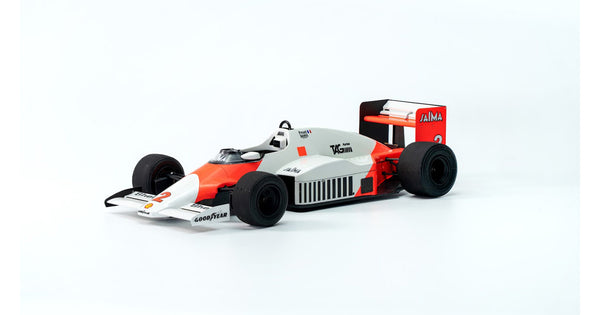These are plastic model sets that require assembly and painting. They do not contain paints and glues unless otherwise stated.
McLaren, established by New Zealand-born racer Bruce McLaren, stands as one of the most esteemed teams in the world of Formula One. From 1984 to 1986, McLaren raced with the renowned McLaren MP4/2 series, a creation of the skilled designer John Barnard. This series introduced the early adoption of a carbon fibre monocoque chassis and was powered by a 1,499cc V6 turbocharged engine.
Funding from Techniques d'Avant Garde (TAG) and technical expertise from Porsche played a crucial role in developing the engine, which bore the designation TTE POl, more commonly known as "TAG" or "TAG-Porsche." The turbo engine, initially introduced at the end of the previous season, underwent significant improvements for the 1984 season, resulting in enhanced power and fuel efficiency. These improvements, combined with the newly developed MP4/2, led to outstanding success. Alain Prost and Niki Lauda secured a remarkable 12 out of 16 race victories in 1984, propelling McLaren to a well-deserved Constructors' Championship. In a tightly contested battle, Niki Lauda clinched the World Championship, narrowly surpassing Alain Prost by a mere 0.5 points.
The following year, in 1985, the car was adapted to meet evolving regulations and became the MP4/2B. Alain Prost made a strong statement in the season opener by winning the Brazilian GP and setting the fastest lap. Prost, often referred to as "The Professor," demonstrated his tactical driving skills throughout the season, securing victories at prominent races, including Monaco (the 4th round), Great Britain (the 8th round), Austria (the 10th round), and Italy (the 12th round). His consistent podium finishes displayed remarkable reliability. In 1985, Alain Prost replaced the retiring Niki Lauda and claimed his first Drivers' Championship, while McLaren clinched the Constructors' Championship for the second consecutive year.
The success story continued in 1986, with Alain Prost once again securing the Drivers' Championship, cementing the legacy of the "Prost and McLaren MP4/2" era.








